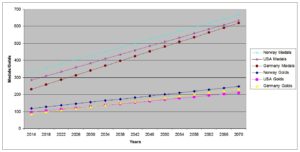In late November 2016 Hilary Evans (@OlyStatman) and I published a blog on this site about the IOC (International Olympic Committee) re-testing of the 2008-12 Olympic drug tests. In that blog, we noted that there were 104 positive tests for doping at those 2 Games, and gave details of which nations, which sports, and which drugs were involved. Please see https://olympstats.com/2016/11/28/summary-of-the-ioc-re-testing-from-2008-2012-to-date/ for the original summary.
Since that blog was published the re-testing has gone on, and the IOC has actually had six further releases in IOC News, announcing further sanctions. As a result, the 104 positive tests number is now only a memory, and today’s blog is to give a further update on the current status of the IOC re-tests from the 2008-12 Olympics.
As of 1 April 2017, there have now been 182 positive drug tests from the 2008 and 2012 Olympics, which includes the original positive tests and the positive re-tests over the previous 20 months or so. Of these, there were 81 positives from the 2008 Beijing Olympics, and 101 from the 2012 London Olympics. Of these 182 positives, 9 athletes tested positive at both the 2008 and 2012 Olympics, so there have been 173 athletes sanctioned. The 9 doping Grand Slam winners are as follows, with Ilyin losing 2 gold medals and Ostapchuk losing a gold and a bronze:
[table]
Name,Gender,NOC,Sport
Andrey Mikhnevich,M,BLR,ATH
Hripsime Khurshudyan,F,ARM,WLT
Ilya Ilyin,M,KAZ,WLT
İntiqam Zairov,M,AZE,WLT
Irina Kulesha,F,BLR,WLT
Ivan Tikhon,M,BLR,ATH
Maiya Maneza,F,KAZ,WLT
Nadezhda Ostapchuk,F,BLR,ATH
Oksana Menkova,F,BLR,ATH
[/table]
In the above, you will note that 5 athletes were from Belarus and 2 from Kazakhstan. Of the 182 sanctions given, the national breakdown is as follows:
[table]
NOC,###
Russia,48
Belarus,23
Ukraine,18
Turkey,14
Kazakhstan,12
Azerbaijan,6
Moldova,5
Armenia,4
China,4
Greece,4
Brazil,3
Spain,3
Germany,3
United States,3
Colombia,2
Cuba,2
Italy,2
Saudi Arabia,2
Morocco,2
Norway,2
Qatar,2
Uzbekistan,2
Albania,1
Bahrain,1
Bulgaria,1
Croatia,1
Cyprus,1
France,1
Georgia,1
Ireland,1
Jamaica,1
Poland,1
DPR Korea (North),1
Saint Kitts and Nevis,1
Slovenia,1
Syria,1
Trinidad & Tobago,1
Vietnam,1
Total,182
[/table]
Of these, 65.4% are from former Soviet nations. While quite high, that is better than in the 28 November 2016 blog, when, of the 104 positive tests, 82.7% came from former Soviet nations.
The breakdown by sport is as follows:
[table]
Sport,###
Athletics,103
Weightlifting,50
Equestrian Events,7
Cycling,6
Wrestling,6
Gymnastics,2
Shooting,2
Boxing,1
Canoeing,1
Judo,1
Modern Pentathlon,1
Rowing,1
Swimming,1
Total,182
[/table]
Here, athletics (track & field) accounts for 56.6% of the positive tests, while athletics and weightlifting together comprise 84.1% of all the positive tests. It should be noted that the equestrian positives involve doping of the horses, in most cases with capsaicin, a topical anti-inflammatory medication derived from chili peppers.
As to what the athletes are taking, the trend is the same as back in November 2016 with the three biggest offenders being turinabol (dehydrochloromethyltestosterone), stanozolol (7β-Hydroxy-17α-methyl-5α-androstano[3,2-c]pyrazole), both of which are anabolic steroids, and biological passport offenses. The breakdown by drugs is given in the following table. Note that the total comes to well over 182 (222) because many athletes tested positive for 2 or more drugs.
[table]
Drug,###
Turinabol,78
Stanozolol,42
Biologic passport offense,32
Oxandrolone,9
Erythropoietin,7
Capsaicin,6
Furosemide,4
Methylhexanamine,4
Methyltrienolone,4
Testosterone,4
CERA re-test +,3
Clenbuterol,3
Unknown,3
Acetazolamide,2
CERA,2
Drostanolone,2
GHRP-2 & GHRP-2 M2,2
Blast-Off Red,1
Blood doping,1
Felbinac,1
GHRP-2,1
Ipamorelin,1
Marijuana,1
Methandienone,1
Methyltestosterone,1
Nandrolone,1
Other anabolic steroid,1
Propranolol,1
Sample tampering,1
Sibutamine,1
Total,222
[/table]
Please refer again to our previous blog (https://olympstats.com/2016/11/28/summary-of-the-ioc-re-testing-from-2008-2012-to-date/) in which I gave details of exactly what the above drugs were and what they are purported to do. In addition, the legend to the final table in this blog gives brief information on each drug.
As noted in that previous blog, it is very difficult to give full details about medals lost and medals won by nations. In doping sanctions, the results are changed by the International Federations (IFs), while the medals are removed and re-allocated by the IOC. Thus we can provide good information about medals lost, but re-allocation of medals can be a slow process because of appeals to the CAS (Court of Arbitration for Sport) and further legal appeals. Because of the legal risks involved, the IOC moves slowly in re-allocation of medals.
As I noted in some recent tweets, however, re-allocation of Olympic medals is not a given. The classic case in 2008-12 has occurred in the 2012 men’s 94 kg weightlifting event, in which 6 of the top 8 finishers, including the top 4 finishers, all tested positive. Theoretically, the 9th place finisher, Tomasz Zielinski of Poland, could move up to a bronze medal. However, as of 1 April, the IOC has re-allocated the gold and silver medals (to Saeid Mohammadpourkarkaragh of Iran and Kim Min-Jae of Korea, respectively), but has not re-allocated the bronze medal, likely because Zielinski had a doping positive in Rio for spironolactone.
However, as of 1 April 2017, 74 medals have been lost for doping positives in 2008-12, with 18 gold medals removed. The breakdown is as follows, with the detailed breakdown first, followed by tables listing medals lost by sports and nations:
[table]
NOC,Sport,Year,G,S,B,TM
Armenia,Weightlifting,2008,0,0,1,1
Azerbaijan,Wrestling,2008,0,1,0,1
Belarus,Athletics,2008,1,2,3,6
Belarus,Weightlifting,2008,0,1,1,2
Brazil,Equestrian Events,2008,0,0,1,1
Bahrain,Athletics,2008,1,0,0,1
China,Weightlifting,2008,3,0,0,3
Cuba,Athletics,2008,0,1,0,1
Greece,Athletics,2008,0,0,1,1
Italy,Cycling,2008,0,1,0,1
Jamaica,Athletics,2008,1,0,0,1
Kazakhstan,Weightlifting,2008,1,1,1,3
Kazakhstan,Wrestling,2008,0,0,1,1
Norway,Equestrian Events,2008,0,0,1,1
DPR Korea (North),Shooting,2008,0,1,1,2
Russia,Athletics,2008,0,4,2,6
Russia,Weightlifting,2008,0,1,3,4
Russia,Wrestling,2008,0,1,0,1
Turkey,Athletics,2008,0,1,0,1
Turkey,Weightlifting,2008,0,1,0,1
Ukraine,Athletics,2008,0,1,1,2
Ukraine,Modern Pentathlon,2008,0,0,1,1
Ukraine,Weightlifting,2008,0,1,1,2
,Totals,2008,7,18,19,44
Armenia,Weightlifting,2012,0,0,1,1
Belarus,Athletics,2012,1,0,0,1
Belarus,Weightlifting,2012,0,0,2,2
Kazakhstan,Weightlifting,2012,4,0,0,4
Moldova,Weightlifting,2012,0,0,2,2
Russia,Athletics,2012,4,4,1,9
Russia,Weightlifting,2012,0,4,0,4
Russia,Wrestling,2012,0,1,0,1
Turkey,Athletics,2012,2,0,0,2
Ukraine,Athletics,2012,0,1,0,1
Ukraine,Weightlifting,2012,0,0,1,1
United States,Athletics,2012,0,1,0,1
Uzbekistan,Wrestling,2012,0,0,1,1
,Totals,2012,11,11,8,30
,Overal Totals,,18,29,27,74
[/table]
[table]
Sport,G,S,B,TM
Athletics,10,15,8,33
Weightlifting,8,9,13,30
Wrestling,0,3,2,5
Shooting,0,1,1,2
Equestrian Events,0,0,2,2
Cycling,0,1,0,1
Modern Pentathlon,0,0,1,1
Totals,18,29,27,74
[/table]
[table]
NOC,G,S,B,TM
Russia,4,15,6,25
Belarus,2,3,6,11
Kazakhstan,5,1,2,8
Ukraine,0,3,4,7
Turkey,2,2,0,4
China,3,0,0,3
DPR Korea (North),0,1,1,2
Armenia,0,0,2,2
Moldova,0,0,2,2
Bahrain,1,0,0,1
Jamaica,1,0,0,1
Azerbaijan,0,1,0,1
Cuba,0,1,0,1
Italy,0,1,0,1
United States,0,1,0,1
Brazil,0,0,1,1
Greece,0,0,1,1
Norway,0,0,1,1
Uzbekistan,0,0,1,1
Total,18,29,27,74
[/table]
For completeness, at the end of this blog, we will list all 182 positive tests to date, which also details medals removed, sorted, in order, by year, nation, sport, and gender.
I will also repeat a paragraph from the November 2016: “These athletes did break the rules and this certainly looks terrible, but it’s important to remember one thing about this. The IOC tries to catch the drug cheats, more so than in most professional sports, notably in the four major pro sports in the United States (although baseball has gotten much better in recent years). Further, the WADA penalties are far more punitive than those in US professional sports, especially the NFL where a positive drug test costs you 4 games, or ¼th of a season, versus 2 calendar years or more in Olympic sports. It is easy to criticize the IOC for this plethora of positive tests, but one should also note that they took the trouble to do the re-testing, something we will almost never see from the NFL or other professional sports.”
So, in summary, the numbers have significantly increased since our last report on this in November 2016, however, the trends are similar. The most affected sports have been athletics and weightlifting, by far, and the nations involved have tended to be former Soviet nations, led by Russia, Belarus, and the Ukraine. The testing is ongoing, so watch this space.
[table]
Name,Gdr,NOC,Sport,Year,Events,Places,Medal,Violations
Hripsime Khurshudyan,F,ARM,WLT,2008,75kg,11,,Stan
Tigran G. Martirosyan,M,ARM,WLT,2008,69kg,3,B,Turin; Stan
Sərdar Həsənov,M,AZE,WLT,2008,62kg,DNF,,Turin
Nizami Paşayev,M,AZE,WLT,2008,94kg,5,,Turin; Oxan; Stan
İntiqam Zairov,M,AZE,WLT,2008,85kg,9,,Turin
Vitaliy Rəhimov,M,AZE,WRE,2008,60kgGR,2,S,Turin
Nataliya Kh’enko-Mi’vich,F,BLR,ATH,2008,SP,2,S,Meth; Stan
Oksana Menkova,F,BLR,ATH,2008,HT,1,G,Turin; Oxan
Nadezhda Ostapchuk,F,BLR,ATH,2008,SP,3,B,Turin; Stan
Darya Pchelnik,F,BLR,ATH,2008,HT,4,,Turin
Svetlana Usovich,F,BLR,ATH,2008,800m/4×400,r2 / 4,,Turin
Irina Kulesha,F,BLR,WLT,2008,75kg,4,,Turin
Anastasiya Novikova,F,BLR,WLT,2008,53kg,3,B,Turin; Stan
Vadim Devyatovsky,M,BLR,ATH,2008,HT,2,S,Testo
Pavel Lyzhin,M,BLR,ATH,2008,SP,4,,Turin
Andrey Mikhnevich,M,BLR,ATH,2008,SP,3,B,Clen; Meth; Oxan
Ivan Tikhon,M,BLR,ATH,2008,HT,3,B,Testo
Andrey Rybakov,M,BLR,WLT,2008,83kg,2,S,Turin; Stan
Rodrigo Pessoa,M,BRA,EQU,2008,Jump/Team,=27 / 10,,Capsaicin
Bernardo Resende,M,BRA,EQU,2008,Jump/Team,=3 / 10,B,Capsaicin
Rashid Ramzi,M,BRN,ATH,2008,1500m,1,G,CERA re-test +
Tezdzhan Naimova,F,BUL,ATH,2008,100m,Heats,,Sample tampering
Cao Lei,F,CHN,WLT,2008,75kg,1,G,GHRP-2 + M2
Chen Xiexia,F,CHN,WLT,2008,48kg,1,G,GHRP-2 + M2
Liu Chunhong,F,CHN,WLT,2008,69kg,1,G,Sibut; GHRP-2
Vanja Perišić,F,CRO,ATH,2008,800m,r1,,CERA re-test +
Yarelis Barrios,F,CUB,ATH,2008,DT,2,S,Acetazolamide.
Wilfredo Martínez,M,CUB,ATH,2008,LJ,5,,Acetazolamide.
Alissa Kallinikou,F,CYP,ATH,2008,400m,5 h7 r1/3,,Testo
Josephine Onyia,F,ESP,ATH,2008,100HH,r2/3,,MHX
Maribel Moreno,F,ESP,CYC,2008,Non-competitor,DNS,,EPO
Stefan Schumacher,M,GER,CYC,2008,ITT/Road race,13 / DNF,,CERA
Christian Ahlmann,M,GER,EQU,2008,Jump/Team,=28 / 8,,Capsaicin
Marco Kutscher,M,GER,EQU,2008,Jump/Team,38 /8,,Capsaicin
Pigi Devetzi,F,GRE,ATH,2008,LJ/TJ,14 / 3,B,Stan
Fani Khalkia,F,GRE,ATH,2008,Non-competitor,DNS,,MTri
Athanasia Tsoumeleka,F,GRE,ATH,2008,20K wk,9,,CERA re-test +
Tasos Gousis,M,GRE,ATH,2008,Non-competitor,DNS,,MTri
Denis Lynch,M,IRL,EQU,2008,Jumping,=8,,Capsaicin
Davide Rebellin,M,ITA,CYC,2008,Road race,2,S,CERA
Nesta Carter,M,JAM,ATH,2008,4×100,1,G,MHX
Mariya Grabovetskaya,F,KAZ,WLT,2008,+75kg,3,B,Turin; Oxan; Stan
Maiya Maneza,F,KAZ,WLT,2008,63kg,DNS,,Stan
Irina Nekrasova,F,KAZ,WLT,2008,63kg,2,S,Stan
Ilya Ilyin,M,KAZ,WLT,2008,94 kg,1,G,Stan
Vladimir Sedov,M,KAZ,WLT,2008,85kg,4,,Stan
Aset Mambetov,M,KAZ,WRE,2008,96kgGR,3,B,Stan
Alexandru Dudoglo,M,MDA,WLT,2008,69kg,9,,Stan
Tony André Hansen,M,NOR,EQU,2008,Jump/Team,1QR / 3,B,Capsaicin
Adam Seroczyński,M,POL,CAN,2008,K2-1000,4,,Clen
Kim Jong-Su,M,PRK,SHO,2008,AP/FP,3 / 2,B/S,Propran
Samuel Francis,M,QAT,ATH,2008,100m,r3,,Stan
Mariya Abakumova,F,RUS,ATH,2008,JT,2,S,Turin
Inga Abitova,F,RUS,ATH,2008,10K,6,,Turin
Yuliya Chermo’skaya,F,RUS,ATH,2008,200m/4×100,r3 / 1,,Turin; Stan
Anna Chicherova,F,RUS,ATH,2008,HJ,3,B,Turin
Tatyana Firova,F,RUS,ATH,2008,400m/4×400,6 / 2,S,Turin; other AS
Anast. Kapa’skaya,F,RUS,ATH,2008,400m/4×400,5 / 2,S,Turin; Stan
Tatyana Lebedeva,F,RUS,ATH,2008,LJ/TJ,2 / 2,S,Turin
Yelena Slesarenko,F,RUS,ATH,2008,HJ,4,,Turin
Yekaterina Volkova,F,RUS,ATH,2008,Steeple,3,B,Turin
Marina Shainova,F,RUS,WLT,2008,58kg,2,S,Turin; Stan
Nadezhda Yevstyukhina,F,RUS,WLT,2008,75kg,3,B,Turin; EPO
Denis Alekseyev,M,RUS,ATH,2008,400m/4×400,r1 / 3,,Turin
Aleksandr Pogorelov,M,RUS,ATH,2008,Decathlon,4,,Turin
Ivan Yushkov,M,RUS,ATH,2008,SP,10,,Turin; Oxan; Stan
Khadzhimurat Akkayev,M,RUS,WLT,2008,94kg,3,B,Turin
Dmitry Lapikov,M,RUS,WLT,2008,105kg,3,B,Turin
Khasan Baroyev,M,RUS,WRE,2008,120kgGR,2,S,Turin
Elvan Abeylegesse,F,TUR,ATH,2008,5K,2,S,Stan
Sibel Özkan,F,TUR,WLT,2008,48kg,2,S,Stan
Nurcan Taylan,F,TUR,WLT,2008,48kg,DNF,,Stan
Liudmyla Blonska,F,UKR,ATH,2008,LJ/Hept,3QR / 2,S,MTS
Vita Palamar,F,UKR,ATH,2008,HJ,5,,Turin
Viktoriya Tereshchuk,F,UKR,MOP,2008,Individual,3,B,Turin
Nataliya Davydova,F,UKR,WLT,2008,69kg,3,B,Turin
Olha Korobka,F,UKR,WLT,2008,+75kg,2,S,Turin
Denys Yurchenko,M,UKR,ATH,2008,PV,3,B,Turin
Ihor Razoronov,M,UKR,WLT,2008,105 kg,6,,Nandro
Courtney King-Dye,F,USA,EQU,2008,Dress/Team,13 / 4,,Felbinac
Thị Ngân Thương Đỗ,F,VIE,GYM,2008,All-Around +4Apps,59,,Lasix
Hysen Pulaku,M,ALB,WLT,2012,77 kg.,DNS,,Stan
Hripsime Khurshudyan,F,ARM,WLT,2012,+75kg,3,B,Turin; Stan
Norayr Vardanyan,M,ARM,WLT,2012,94kg,11,,Turin
Boyanka Kostova,F,AZE,WLT,2012,58kg,5,,Turin; Stan
İntiqam Zairov,M,AZE,WLT,2012,94kg,6,,Turin
Anastasiya Ivanova-Shvedova,F,BLR,ATH,2012,PV,17,,Turin
Nataliya Koreyvo,F,BLR,ATH,2012,1500m,7,,BPO
Oksana Menkova,F,BLR,ATH,2012,HT,7,,Turin; Stan
Nadezhda Ostapchuk,F,BLR,ATH,2012,SP,1,G,Methen
Irina Kulesha,F,BLR,WLT,2012,75kg,3,B,Turin
Dina Sazanovets,F,BLR,WLT,2012,69kg,4,,Drost; Stan
Marina Shkermankova,F,BLR,WLT,2012,69kg,3,B,Turin; Stan
Pavel Kryvitsky,M,BLR,ATH,2012,HT,28,,Turin; Stan
Andrey Mikhnevich,M,BLR,ATH,2012,SP,17QR,,Clen; Meth; Oxan
Ivan Tikhon,M,BLR,ATH,2012,Pre-games test,DNS,,Meth
Yevgeny Zhernosek,M,BLR,WLT,2012,+105kg,9,,Turin; Oxan; Stan
Kissya Costa,F,BRA,ROW,2012,Single sculls,18,,EPO
Wang Jianan,F,CHN,ATH,2012,Marathon,58,,BPO
Yolanda Caballero,F,COL,ATH,2012,Marathon,DNF,,BPO
Diego Palomegue,M,COL,ATH,2012,Pre-games testing,DNS,,Stan
Marta Domínguez,F,ESP,ATH,2012,Steeple,12,,BPO
Hassan Hirt,M,FRA,ATH,2012,5K,11h1 r1/2,,EPO
Raul Tsirek’idze,M,GEO,WLT,2012,85kg,9,,Turin; Stan
Alex Schwazer,M,ITA,ATH,2012,Pre-games test,DNS,,EPO
Zulfiya Chinshanlo,F,KAZ,WLT,2012,53kg,1,G,Oxan; Stan
Maiya Maneza,F,KAZ,WLT,2012,63kg,1,G,Stan
Svetlana Podobedova,F,KAZ,WLT,2012,75kg,1,G,Stan
Ilya Ilyin,M,KAZ,WLT,2012,94kg,1,G,Turin; Stan
Almas Uteshov,M,KAZ,WLT,2012,94kg,7,,Turin; Stan
Taymuraz Tigiyev,M,KAZ,WRE,2012,94kgFS,=14,,Turin
Hussain Al-Hamdah,M,KSA,ATH,2012,5K,19r1/2,,BPO
Mohammed Shaween,M,KSA,ATH,2012,1500m,Semis,,BPO
Amine Laâlou,F,MAR,ATH,2012,Pre-games test,DNS,,Lasix
Abderrahhime Bouramdane,M,MAR,ATH,2012,Marathon,DNF,,BPO
Zalina Marghiev,F,MDA,ATH,2012,Hammer,8,,Turin; Stan
Marina Marghiyev,F,MDA,ATH,2012,Pre-games test,DNS,,Lasix
Cristina Iovu,F,MDA,WLT,2012,53kg,3,B,Turin
Anatolii Cîrîcu,M,MDA,WLT,2012,94kg,3,B,Turin
Hamza Driouch,M,QAT,ATH,2012,1500m,10r2,,BPO
Yelena Arzhakova,F,RUS,ATH,2012,800m,6,,BPO
Mariya Bespalova,F,RUS,ATH,2012,HT,8,,Unknown
Tatyana Chernova,F,RUS,ATH,2012,Heptathlon,3,B,Turin
Vera Ganeyeva,F,RUS,ATH,2012,DT,23 QR,,Turin
Yelizaveta Grechishnikova,F,RUS,ATH,2012,10K,19r1,,BPO
Olga Kaniskina,F,RUS,ATH,2012,20K wk,2,S,BPO
Gulfiya Khanafeyeva,F,RUS,ATH,2012,HT,13,,Turin
Yevgeniya Kolodko,F,RUS,ATH,2012,SP,2,S,Turin; Ipamo
Yekaterina Kostetskaya,F,RUS,ATH,2012,1500m,9,,BPO
Antonina Krivoshapka,F,RUS,ATH,2012,400m/4×400,6 / 2,S,Turin
Tatyana Lysenko,F,RUS,ATH,2012,HT,1,G,Unknown
Yekaterina Martynova,F,RUS,ATH,2012,1500m,r1/3,,BPO
Darya Pishchalnikova,F,RUS,ATH,2012,DT,2,S,Oxan
Mariya Savinova,F,RUS,ATH,2012,800m,1,G,BPO
Viktoriya Valyukovich,F,RUS,ATH,2012,TJ,8,,Turin
Yuliya Zaripova,F,RUS,ATH,2012,Steeple,1,G,Turin
Viktoriya Baranova,F,RUS,CYC,2012,Pre-games testing,DNS,,Testo
Yekaterina Gnidenko,F,RUS,CYC,2012,Kieren/Sprint,8 / 18,,Turin
Svetlana Tsarukayeva,F,RUS,WLT,2012,63kg,2,S,Turin
Nataliya Zabolotnaya,F,RUS,WLT,2012,75kg,2,S,Turin
Sergey Bakulin,M,RUS,ATH,2012,50K wk,5,,BPO
Valeriy Borchin,M,RUS,ATH,2012,20K wk,DNF,,BPO
Kirill Ikonnikov,M,RUS,ATH,2012,HT,5,,Turin
Vladimir Kanaykin,M,RUS,ATH,2012,20K wk,DNF,,BPO
Sergey Kirdyapkin,M,RUS,ATH,2012,50K wk,1,G,BPO
Dmitry Starodubtsev,M,RUS,ATH,2012,PV,4,,Turin
Igor Yerokhin,M,RUS,ATH,2012,50K wk,5,,BPO
Apti Aukhadov,M,RUS,WLT,2012,85kg,2,S,Turin; Drost
Andrey Demanov,M,RUS,WLT,2012,94kg,4,,Turin
Aleksandr Ivanov,M,RUS,WLT,2012,94kg,2,S,Turin; Stan
Besik Kudukhov,M,RUS,WRE,2012,60kgFS,2,S,Turin
Tameka Williams,F,SKN,ATH,2012,100m/200m,DNS,,Blast-Off Red
Blaža Klemenčič,F,SLO,CYC,2012,MTB,23,,EPO
Ghfran Mouhamad,F,SYR,ATH,2012,400IH,8 h2 r1/3,,MHX
Semoy Hackett,F,TTO,ATH,2012,100m/200m/4×100,Hts / 8 / Final,,MHX
Aslı Çakır,F,TUR,ATH,2012,1500m,1,G,BPO
Gamze Bulut,F,TUR,ATH,2012,1500m,2,G,BPO
Bahar Doğan,F,TUR,ATH,2012,Marathon,62,,BPO
Ümmü Kiraz,F,TUR,ATH,2012,Marathon,88,,BPO
Semiha Mutlu,F,TUR,ATH,2012,20K wk,47,,BPO
Meliz Redif,F,TUR,ATH,2012,4×400,r1,,BPO
Pınar Saka,F,TUR,ATH,2012,400m/4×400,4r1/3 / 8r1/2,,BPO
Binnaz Uslu,F,TUR,ATH,2012,Steeple,15r1,,BPO
Nevin Yanıt,F,TUR,ATH,2012,100HH,5,,Blood doping
Sibel Şimşek,F,TUR,WLT,2012,63kg,4,,Turin; Stan
Adem Kılıççı,M,TUR,BOX,2012,75 kg.,=5,,Turin
Tetiana Hamera-Shmyrko,F,UKR,ATH,2012,Marathon,5,,BPO
Liudmyla Iosypenko,F,UKR,ATH,2012,Heptathlon,4,,BPO
Hanna Mishchenko,F,UKR,ATH,2012,1500m,r1,,BPO
Anzhelika Shevchenko,F,UKR,ATH,2012,1500m,13r1/3,,BPO
Svitlana Shmidt,F,UKR,ATH,2012,Steeple,12h3r1/2,,BPO
Marharyta Tverdokhlib,F,UKR,ATH,2012,LJ,25,,Turin; Stan
Olha Beresneva,F,UKR,SWI,2012,10k OW,7,,EPO
Yuliya Kalina,F,UKR,WLT,2012,58kg,3,B,Turin
Oleksandr Dryhol,M,UKR,ATH,2012,HT,34,,Turin
Maksym Mazuryk,M,UKR,ATH,2012,PV,18,,Turin
Oleksandr P’iatnytsia,M,UKR,ATH,2012,JT,2,S,Turin
Tyson Gay,M,USA,ATH,2012,100m/4×100,4 / 2,S,Unknown
Nick Delpopolo,M,USA,JUD,2012,Lightweight,=7,,Marijuana
Luiza Galiulina,F,UZB,GYM,2012,All-Around,DNS,,Lasix
Soslan Tigiyev,M,UZB,WRE,2012,74kgFS,3,B,Turin
[/table]
Table Legend for Violations: BPO = Biological passport offense; CERA = continuous erythropoietin receptor activator (increases red blood cell counts); Clen = Clenbuterol (sympathomimetic anabolic agent); Drost = Drostolone (anabolic steroid); EPO = Erythropoietin (increases red blood cell counts); GHRP-2 = growth hormone releasing peptide (pralmorelin) (increases growth hormone levels); Ipamo = Ipamorelin (GHRP analogue; increases growth hormone levels); Lasix = Furosemide (diuretic); Meth = Methandienone (anabolic steroid); Methen = Methenolone (anabolic steroid); MHX = Methylhexanamine (sympathomimetic amine = stimulant); MTri = Methyltrienolone (anabolic steroid); MTS = Methyltestosterone (anabolic steroid); Nandro = Nandrolone (anabolic steroid); Other AS (anabolic steroid) = 3a-hydroxy-5a-androst-1-en-17-one (anabolic steroid); Oxan = Oxandrolone (anabolic steroid); Propran = Propranolol (ß-blocker, slows heart rate, may increase cardiac output); Sibut = Sibutramine (oral anorexic; helps lose weight); Stan = Stanozolol (anabolic steroid); Testo = Testosterone (anabolic steroid); Turin = Turinabol (anabolic steroid).


